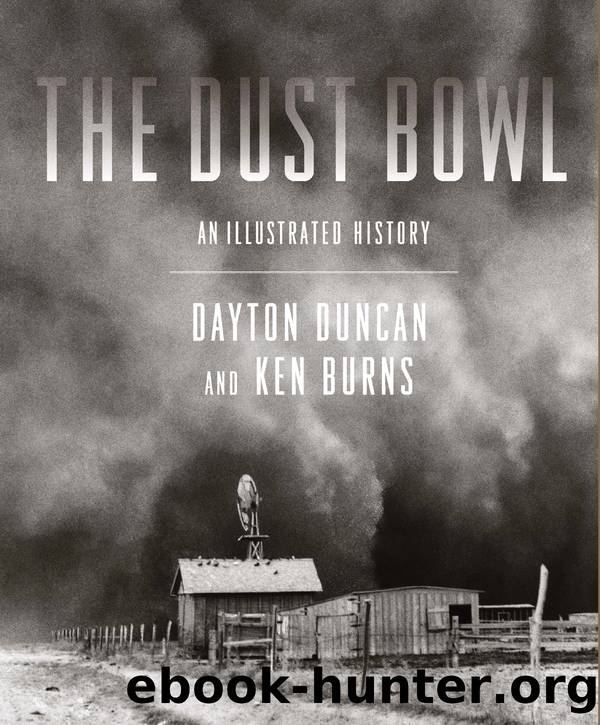The Dust Bowl by Dayton Duncan

Author:Dayton Duncan
Language: eng
Format: epub
ISBN: 9781452119151
Publisher: Chronicle Books LLC
[Plate 160]
In a barren field stripped of most vegetation, soil scientist H. Howard Finnell contemplates the daunting challenge of âOperation Dust Bowl.â
Under typical farming methods, he concluded, nearly 80 percent of a yearâs rainfall never soaked deeply enough into the subsoil to benefit the crops. As a result, wheat farmers could expect only four good harvests out of every ten, even during normal weather conditions. âI realize that agriculture is something of a gamble from the time a man plants his seed until he brings a crop to harvest,â he wrote, âbut I can see no necessity for this kind of gambling⦠The economics of soil conservation are based not on one year, or even ten years, but in the long runâon many years, even centuries.â
In his experimentsâsome based on suggestions by old-timers with long experience on the PlainsâFinnell had discovered techniques to double the odds of a good crop by capturing as much moisture as possible: using terraces and plowing along the landâs contour to minimize runoff; keeping, rather than stripping, plant residues on the surface after a harvest; planting different crops, depending on subsoil conditions; and making deeper rows with the plow called a lister, rather than pulverizing the soil with the more popular one-way plow.
âWe do not want a changed climate,â Finnell wrote. âAll that is needed to reach a solution of many of the drouth problems is to make a better use of the rain that is received. Moisture conservation is the answer.â
In the space of a decade, Finnell had published fifty-nine reports of his findings, but few farmers paid much attention to his recommendations. It was the 1920s, times were good, and they were more interested in finding additional grassland to plow.
But Finnellâs work did catch the eye of Hugh Bennett, the head of the newly created Soil Conservation Service, who quickly hired him and put him in charge of one of the agencyâs largest and hardest hit regions in the nation: nearly 100 million acres of the southern Plainsâan area four times the size of Ohio. Finnellâs first task was to set up some demonstration projects north of Dalhart, where he hoped to prove to skeptical farmers that his techniques were worth following. He persuaded a handful of owners to sign three-year contracts agreeing to cooperate; the government would pay for the work, and any improvements made during that time would belong to the landowner.
It was called âOperation Dust Bowlâ and a lot was riding on the results. In 1935, an estimated 850 million tons of topsoil were being swept off the naked fields of the Plains, where 4 million acres, in 101 counties, were blowing. Predictions called for a million more acres to do the same thing in 1936. One report said the Dust Bowl was expanding eastward at 30 miles a year, and predicted that even cities on the East Coast might ultimately be buried in dust, like some ancient civilizations. âUnless something is done,â another report concluded, âthe western plains will be as arid as the Arabian desert.
Download
This site does not store any files on its server. We only index and link to content provided by other sites. Please contact the content providers to delete copyright contents if any and email us, we'll remove relevant links or contents immediately.
In Cold Blood by Truman Capote(3344)
The Innovators: How a Group of Hackers, Geniuses, and Geeks Created the Digital Revolution by Walter Isaacson(2987)
Steve Jobs by Walter Isaacson(2857)
All the President's Men by Carl Bernstein & Bob Woodward(2346)
Lonely Planet New York City by Lonely Planet(2194)
And the Band Played On by Randy Shilts(2163)
The Room Where It Happened by John Bolton;(2132)
The Poisoner's Handbook by Deborah Blum(2108)
The Murder of Marilyn Monroe by Jay Margolis(2076)
The Innovators by Walter Isaacson(2074)
Lincoln by David Herbert Donald(1962)
A Colony in a Nation by Chris Hayes(1900)
Being George Washington by Beck Glenn(1772)
Under the Banner of Heaven: A Story of Violent Faith by Jon Krakauer(1764)
Amelia Earhart by Doris L. Rich(1668)
The Unsettlers by Mark Sundeen(1658)
Dirt by Bill Buford(1649)
Birdmen by Lawrence Goldstone(1638)
Zeitoun by Dave Eggers(1615)
